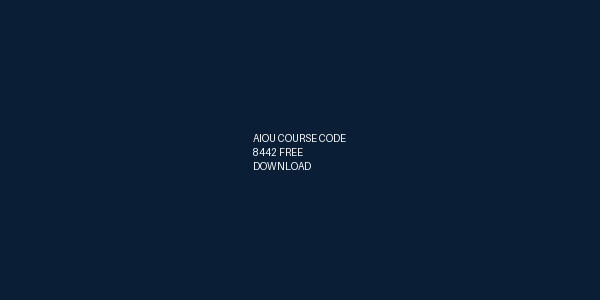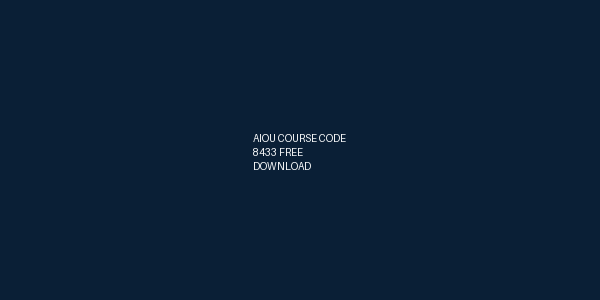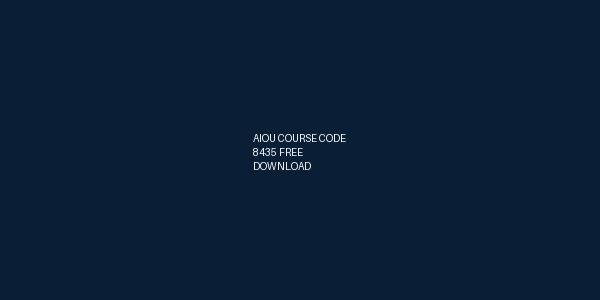AIOU Course Code 8442 Free Download

ALLAM IQBAL OPEN UNIVERSITY ISLAMABAD
(Department of Business Administration)
***
WARNING
- PLAGIARISM OR HIRING OF GHOST WRITER(S) FOR SOLVING THE ASSIGNMENT(S) WILL DEBAR THE STUDENT FROM THE AWARD OF DEGREE/CERTIFICATE IF FOUND AT ANY STAGE.
- SUBMITTING ASSIGNMENTS BORROWED OR STOLEN FROM OTHER(S) AS ONE’S OWN WILL BE PENALIZED AS DEFINED IN THE “AIOU PLAGIARISM POLICY”.
Course: Auditing (8442) Semester: Spring, 2025
Level: BBA
Total Marks: 100 Pass Marks: 50
ASSIGNMENT No. 1
Unit: (1-4)
Note: Attempt all questions. All questions carry equal marks.
Q.No.1. Explain the term audit. What are the various types of audits? Discuss with examples. (20)
Q.No.2. What is an internal control system? Discuss the internal control system for investment with examples. (20)
Q.No.3. What are the various types of probability sampling? Discuss with examples. (20)
Q.No.4. Explain the term vouching and discuss its importance. Critically discuss the vouching process of cash in detail. (20)
Q.No.5 . What is an internal check-in audit? Discuss the process of internal checks with examples. (20)
Total Marks: 100 Pass Marks: 50
ASSIGNMENT No. 2
Unit: (5-9)
Note: Attempt all questions. All questions carry equal marks.
Q.No.1 What are the various problems related to the valuation of assets in your view? Discuss with examples. (20)
Q.No.2 What is a company auditor’s report? Discuss the components of a company auditor's report with examples. (20)
Q.No.3 What are the duties of the management auditor? Discuss with examples. (20)
Q.No.4 How does flow chart analysis help the auditor in managing the effective audit process? Discuss with examples. (20)
Q.No.5 What is the process of investigation to be conducted regarding purchases? Discuss with examples.
(20)
AUDITING (8442)
UNIT 1: INTRODUCTION TO AUDITING
- Historical Development of Auditing
- Various Definitions of Auditing
- Objectives of an Audit
- Auditing Distinguished from Bookkeeping and Accounting
- Qualification of an Auditor
- Professional Ethics
- Types of Audits
- Consideration to Begin a New Audit
UNIT 2: INTERNAL CONTROL, INTERNAL CHECK, AND INTERNAL AUDIT
- The System of Internal Control
- Evaluation of Internal Control
- Types of Internal Control
- Internal Check
- Internal Audit
- Practical Applications
- Overall Financial Control
- Receipt And Payments of Cash
- Control of Funds
- Balances Held
- Cheque Payments
- Remuneration Of Employees
- Trading Transactions
- Stock Control
- Fixed Assets
- Investment
UNIT 3: AUDIT SAMPLING
- Introduction to Sampling
- The Basis for Sample Selection
- The Sample Size
- Methods of Sample Selection
- Sample Evaluation
- Sampling in Practice
Unit 4: VOUCHING AND EXAMINATION OF GENERAL RECORDS
- Vouching its Meaning
- Distinction between Vouching and Routine Checking
- Audit and Vouching
- Vouching Technique
- Vouching of Cash Book
- Receipt Side
- Payment Side
Unit 5: Verification of assets and liabilities
- Meaning of Verification
- Problems in The Valuation of Assets
- Fixed Assets
- Floating Assets and Mode of Their Valuation
- Wasting Assets
- Intangible Assets and Their Valuation
- Auditors Position as Regards the Valuation of Assets
- Verification of Liabilities
Unit 6: The Company’s Auditor
- Appointment of Auditor
- Qualifications of An Auditor
- Remuneration of Auditor
- Removal of Auditor
- Status of an Auditor
- Rights, Powers and Duties of an Auditor
- Auditor’s Lien
- Preliminaries before the Actual Work
- Audit of Share Capital
- The Auditor’s Report
Unit 7: Management and performance audit
- Definition of Management Audit
- Importance of Management Audit
- Objective of Management Audit
- Criticism of Management Audit
- Distinction between Statutory Audit and Management Audit
- Who Should Conduct the Management Audit
- Preliminary to the Conduct of Management Audit
- Management Audit Program
- Work and Duties of the Management Auditor
- Management Auditor’s Report
Unit 8: Computer Controls and Audit Techniques
- Nature of EDP System
- Hardware
- Soft ware
- Computer Controls
- General Control
- Organization of an EDP Department
- Program Documentation
- Security Contorts
- Application Controls
- Input Controls
- Processing Controls
- Output Controls
- On-Line, Real Time System (OLRT)
- EDP and the Audit Process
- Flow Chart Analysis
- Test Decks
- Generalized Computer Audit Programs.
- Nature of EDP System
UNIT 9: SPECIAL AUDIT AND INVESTIGATIONS.
- Introduction of Special Audit
- Non-Profit Institutions
- Specialize Audit under other Status
- Investigations
- Events Necessitating an Investigation
- Stages of an Investigation
- Difference between Investigation and Auditing
- Business Purchases
- Profit Forecasts
- Investigation on behalf of a Prospective Lender
- Fraud
- Investigation under the Companies Act.
- Introduction of Special Audit
Book Recommended:
Saeed Amjad Khawaja (updated edition), “Auditing Principles and Procedures” Lahore. Institute of Business Management.

